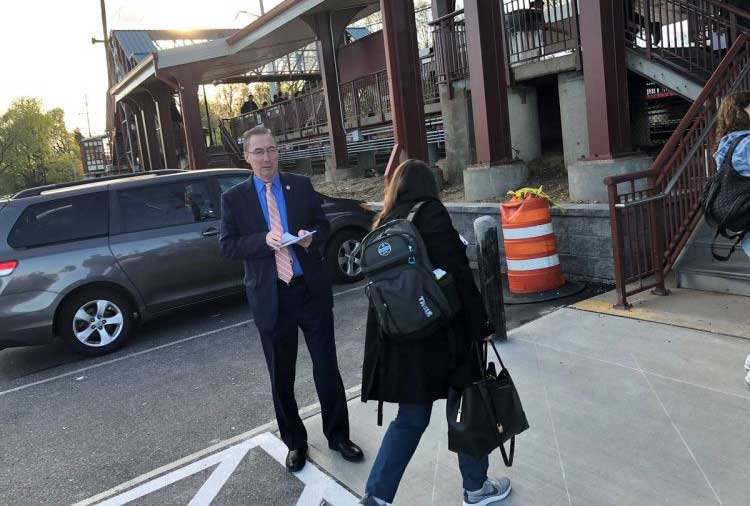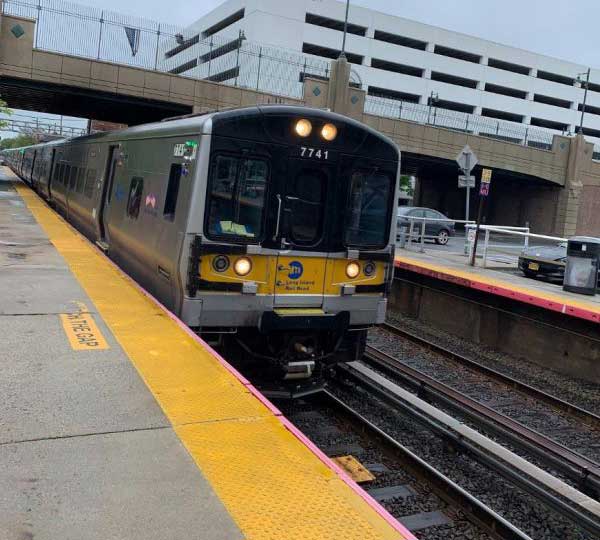By Rich Dolan and Mike Amoruoso
Starting in 2021, a version of what Governor Andrew Cuomo envisioned for a New York City congestion pricing plan will begin charging vehicles a toll to drive below 60th Street into Manhattan. The revenue to be generated was originally dedicated to fixing the Metropolitan Transportation Authority’s fledgling subway system, with no dedicated funds going to the Long Island Rail Road or Metro-North, also run by the MTA. That was until four New York State Senators representing Long Island called for change in Albany.
Spearheading the effort to get LIRR included in the April 1 New York State budget were New York State Senators James Gaughran of District 5, Todd Kaminsky of District 9, Anna M. Kaplan of District 7 and Kevin Thomas of District 6. Their plan was the MTA Revitalization, Accountability, Improvement and Legitimization Act, or the MTA RAIL Act, which calls for increased consolidation and efficiency and an elimination of waste among other improvements.
The MTA RAIL Act is just one of four plans that exist to improve the MTA. There are two internal initiatives for change in the LIRR Forward Plan and the LIRR Modernization Plan. The former focuses on system upgrades and enhancing the customer experience, while the latter aims to tackle large-scale infrastructure projects. The fourth proposal is Gov. Cuomo’s 10-Point Plan which, while not as comprehensive or focused on the LIRR specifically, calls for many of the same changes as the MTA RAIL Act.

Sen. James Gaughran, who represents constituents from Glen Head to Commack, believes that the crucial component of the Act is the independent audit, which he believes will reveal where the MTA is “wasting money on outside consultants” and/or “top heavy on management in high paying jobs.”
“We got hints that those were problems,” Gaughran said at a recent hearing on Long Island. “I questioned MTA officials. I questioned the president of the railroad. It seemed pretty clear to me that they didn’t have set policies.”
Sen. Kevin Thomas also warned that he and his fellow state senators would be holding Phil Eng, president of the LIRR, accountable for waste.
“If we are bringing back 10 percent from the congestion pricing,” said Thomas, “then [Eng] is going to have to show us where that money is going. He is going to have to show us where the improvements are.” As of now, the MTAs official statement is that they are “studying possible consolidations.”
The MTA RAIL Act will take time to develop.
“We can’t expect instant results from problems that have been festering for 200 years,” said Mark Epstein, chair of the Long Island Rail Road Commuter Council, which serves as an advisory board to the MTA but has no voting rights. “We’ve been asked to come to dinner but we can’t eat.” Epstein applauded the proposal as “a big step forward.”
“The problems we constantly hear are about on-time performance and crowded trains,” he said. “People just want an on-time train and a seat.”
Many Long Islanders believe that they are underserved by public transportation, including both the railroad and the buses.
“We need more buses,” said Sen. Gaughran, explaining that Queens is another area that has been rapidly growing and many feel is underserved by the LIRR.
The LIRR has a “third-track expansion project,” which is a $2 billion plan to construct a 9.8-mile long third track between Floral Park and Hicksville over a three year period. The project is expected to alleviate traffic and transport more commuters. In addition, Sen. Gaughran called for the electrification of the Port Jefferson line “creates jams on the platforms.”

“This is a great deal for riders and something we have been pushing for,” said Danny Pearlstein, policy and communication leader for the Rider’s Alliance, an organization that fights for reliable, affordable, public transit.
“The prices are already astronomical and the fact that the prices are rising even higher is a bit ridiculous” said Meghan Gigante, a commuter from Franklin Square and user of the LIRR for over 25 years, who pointed out that because the cars are crowded on her commute, with everyone standing, conductors are unable to collect fares.
“So we have waste there again,” said Sen. Kevin Thomas. “You should be taking in revenue.”
“It’s frustrating when you don’t see all of the things being promised,” agreed Joseph Girardi, a LIRR commuter for eight years. “I would like to see better security on the carts, trains arriving and departing on time, cleaner and more updated carts.” Commuters aren’t the only ones who echo these sentiments.
“People on Long Island deserve to commute to the city without being on a train where the doors don’t open or the bathrooms are not functioning,” said Sen. Thomas. “They deserve to sit on a seat without duct tape on it. They deserve to get on a train and not be told that the train is on time even though the train is 10 minutes late.”
Many commuters transfer from the LIRR to the subway once they’re in the city, where they’re faced with more disappointments.
“The subway is in crisis and has been for several years and it has really deteriorated,” said Pearlstein of the Rider’s Alliance. “Service really deteriorated, trains became a lot slower, less reliable, and so what we’re looking for is to restore reliability to the subway system so people can count on getting to places on time.”
There seems to be help on the way though, added Pearlstein, now that “there is a plan to fully modernize the subway with new signals, new subway cars, and new elevators.”
“We have an unprecedented transformation of the LIRR underway,” said an MTA spokesperson, “with billions of dollars being invested in 100 capital projects across the system to modernize the system and improve reliability, capacity, and customer experience.” Some improvements include projects to upgrade and renew stations, bridges, parking facilities, and grade crossings, as well as expansions like Third Track and East Side Access, which will provide LIRR service to the east side of Manhattan at Grand Central Terminal and is expected to be competed in December of 2022.






